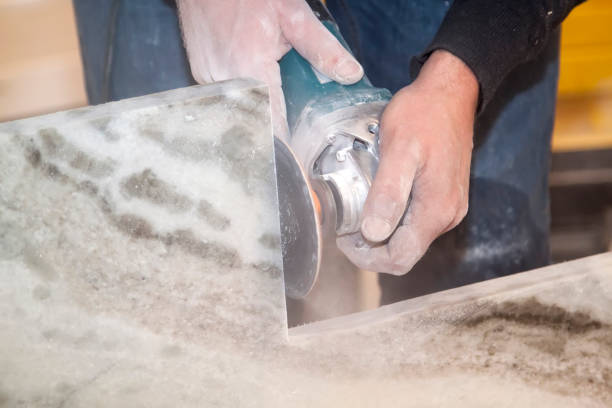How to Cut Cultured Marble:

Introduction
Cutting cultured marble is a crucial skill for anyone embarking on a remodeling or construction project. Cultured marble, a blend of marble dust and high-strength resin, offers a luxurious and affordable alternative to natural stone. Knowing how to cut cultured marble effectively can make all the difference in achieving precise and professional results. Whether you’re crafting a custom vanity top, installing shower walls, or creating bespoke accents, mastering the art of cutting cultured marble is indispensable. In this expert guide, we’ll delve into the essential techniques and safety measures required to cut cultured marble like a seasoned pro. By the end, you’ll be equipped with the knowledge and confidence to tackle your next project with finesse and precision.
Safety Precautions
When it comes to cutting cultured marble, prioritizing safety is non-negotiable. Proper safety gear and precautions are paramount to safeguarding yourself during the cutting process. Cultured marble cutting involves the use of tools that generate dust and debris, emphasizing the critical need for protective measures. From respirators to eye protection, the right safety gear is essential for shielding against potential hazards. In this section, we’ll explore the significance of safety gear and outline best practices to ensure your well-being while cutting cultured marble. By adhering to these safety protocols, you can approach the task with confidence and peace of mind, knowing that you’re safeguarded throughout the cutting process.
Tools and Materials
When it comes to cutting cultured marble, having the right tools and materials at your disposal is the key to achieving precise and professional results. Each tool plays a crucial role in ensuring a smooth and efficient cutting process. The diamond blade saw stands as the backbone of the operation, providing the necessary sharpness and strength to cut through the dense material with minimal chipping. Meanwhile, safety gear such as masks, respirators, eye protection, work gloves, and hearing protection form a protective shield against dust, debris, and noise, prioritizing your well-being throughout the task. By understanding the significance of these tools and materials, you can approach the art of cutting cultured marble with a con Diamond Blade Saw: A specialized saw blade designed to cut through cultured marble with precision, minimizing chipping and damage.
Tools
Mask and Respirator: Essential for protecting against inhaling marble dust, ensuring respiratory safety during the cutting process.
Eye Protection: Safety goggles or a face shield to shield the eyes from debris and particles generated while cutting.
Work Gloves: Durable gloves provide protection and enhance grip when handling cultured marble and tools.
Hearing Protection: Earplugs or earmuffs to reduce exposure to high levels of noise produced by cutting machineryfidence and readiness, knowing that you’re equipped for success.
Preparation
Preparing cultured marble for the cutting process is a crucial precursor to achieving precise and flawless results. By following essential steps and ensuring the work area is primed for the task, you lay the foundation for a seamless cutting experience. From marking the cutting lines to securing the marble in place, each preparatory step contributes to the overall success of the cutting endeavor. Additionally, ensuring that the work area is organized, clean, and free from potential obstructions is paramount to guaranteeing a safe and efficient cutting process. By diligently preparing both the material and the work environment, you can embark on the cutting process with confidence, knowing that you’ve set the stage for a successful outcome.
Cutting Techniques
Mastering the art of cutting cultured marble involves understanding various cutting techniques and implementing precise methods to achieve immaculate results. Whether it’s using a diamond blade saw for straight cuts or employing specialized techniques for curved or intricate patterns, the key lies in honing the right skills for each cutting approach. Additionally, incorporating tips such as maintaining a steady hand, adjusting cutting speeds, and periodically clearing debris can significantly enhance the precision of the cuts. By delving into the nuances of different cutting techniques and leveraging expert tips, you can elevate your proficiency in working with cultured marble, ensuring that each cut reflects the precision and finesse required for exceptional outcomes.
Finishing and Polishing
Achieving impeccably finished and polished edges on cultured marble is the hallmark of a professional and meticulous approach. From sanding and smoothing the cut edges to applying a high-quality polishing compound, each step contributes to the creation of a flawless final product. By carefully following the recommended steps and applying expert techniques, you can elevate the aesthetic appeal of the cut edges to a professional standard. Furthermore, incorporating best practices such as using fine-grit sandpaper and consistently inspecting the edges for uniformity ensures that the finished result exudes the refinement and sophistication characteristic of premium cultured marble surfaces. With the right methods and attention to detail, you can achieve a polished finish that truly enhances the overall allure of the cultured marble.
Hearing Protection: Earplugs or earmuffs to reduce exposure to high levels of noise produced by cutting machinery
Marble – rocks and minerals
Marble, a mesmerizing metamorphic rock, enthralls with its striking beauty and versatile applications. Formed through the metamorphism of limestone, marble boasts an array of potential uses that transcend almost any other rock. Its primary mineral, calcium carbonate, undergoes recrystallization, resulting in interlocking grains that define the rock’s distinctive properties. With its non-foliated texture and medium- to coarse-grained composition, marble captivates with a range of colors, from classic white to elegant pink. This rock’s enduring allure stems from its chameleon-like ability to transform from sedimentary limestone to the exquisite metamorphic marvel known as marble. The intrinsic connection between marble and its mineral components, such as calcite and dolomite, lends it unparalleled elegance and makes it a coveted material across diverse industries.
Conclusion
In conclusion, understanding the intricacies of working with cultured marble, from cutting techniques to finishing touches, empowers individuals to embark on their projects with confidence and finesse. By mastering the art of cutting, enthusiasts can unleash their creativity, shaping cultured marble into stunning designs that reflect precision and skill. The meticulous process of finishing and polishing not only elevates the aesthetic appeal but also imbues a sense of professionalism to the final product. As readers delve into the fascinating world of marble, they are encouraged to translate their newfound knowledge into tangible, awe-inspiring creations. Whether it’s crafting bespoke countertops, elegant sculptures, or captivating architectural elements, the applications of cultured marble are as boundless as the imagination.
With a wealth of resources and guidance at their disposal, enthusiasts are poised to embark on their marble-centric endeavors with enthusiasm and determination. By embracing best practices and incorporating expert tips, they can infuse their projects with an unparalleled level of refinement and artistry. As they hone their skills through practice and exploration, they will witness their creations evolve into masterpieces that captivate and inspire. The journey of working with cultured marble is not just about the result, but the joy of learning, creating, and experiencing the transformative beauty of this exquisite material. penguintalks.com





